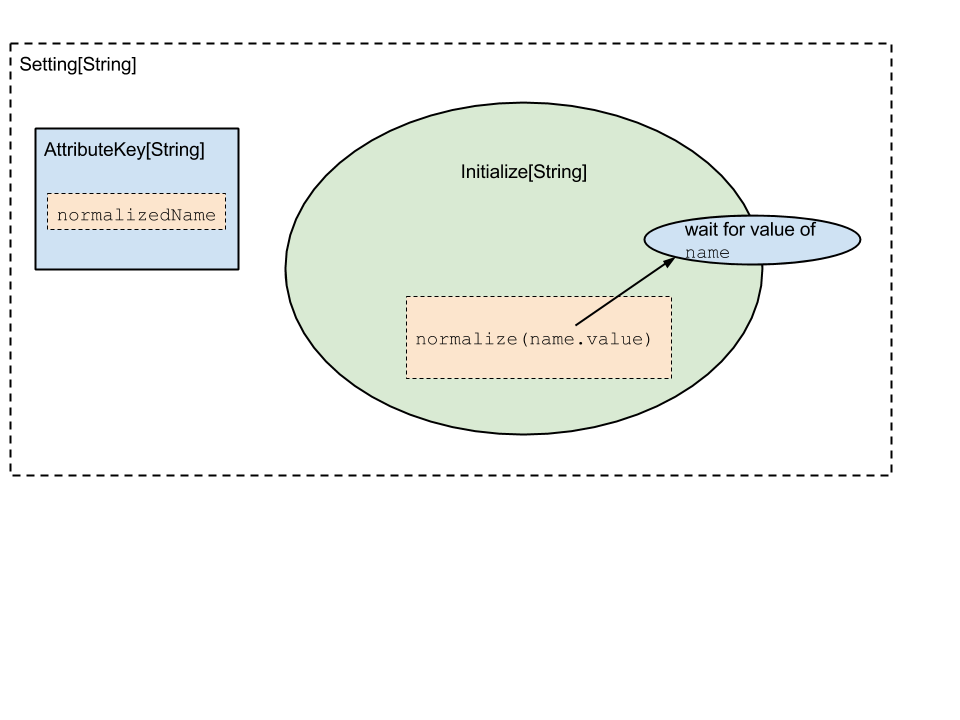- Core Principles
Core Principles
This document details the core principles overarching sbt’s design and code style. sbt’s core principles can be stated quite simply:
- Everything should have a
Type, enforced as much as is practical. - Dependencies should be explicit.
- Once learned, a concept should hold throughout all parts of sbt.
- Parallel is the default.
With these principles in mind, let’s walk through the core design of sbt.
Introduction to build state
This is the first piece you hit when starting sbt. sbt’s command engine is the means by which it processes user requests using the build state. The command engine is essentially a means of applying state transformations on the build state, to execute user requests.
In sbt, commands are functions that take the current build state
(sbt.State) and produce the next state. In other words, they are
essentially functions of sbt.State => sbt.State. However, in reality,
Commands are actually string processors which take some string input and
act on it, returning the next build state.
So, the entirety of sbt is driven off the sbt.State class. Since this
class needs to be resilient in the face of custom code and plugins, it
needs a mechanism to store the state from any potential client. In
dynamic languages, this can be done directly on objects.
A naive approach in Scala is to use a Map<String,Any>. However, this
violates tenant #1: Everything should have a Type. So, sbt defines a
new type of map called an AttributeMap. An AttributeMap is a
key-value storage mechanism where keys are both strings and expected
Types for their value.
Here is what the type-safe AttributeKey key looks like :
sealed trait AttributeKey[T] {
/** The label is the identifier for the key and is camelCase by convention. */
def label: String
/** The runtime evidence for ``T`` */
def manifest: Manifest[T]
}
These keys store both a label (string) and some runtime type
information (manifest). To put or get something on the AttributeMap,
we first need to construct one of these keys. Let’s look at the basic
definition of the AttributeMap:
trait AttributeMap {
/** Gets the value of type ``T`` associated with the key ``k`` or ``None`` if no value is associated.
* If a key with the same label but a different type is defined, this method will return ``None``. */
def get[T](k: AttributeKey[T]): Option[T]
/** Adds the mapping ``k -> value`` to this map, replacing any existing mapping for ``k``.
* Any mappings for keys with the same label but different types are unaffected. */
def put[T](k: AttributeKey[T], value: T): AttributeMap
}
Now that there’s a definition of what build state is, there needs to be
a way to dynamically construct it. In sbt, this is done through the
Setting[_] sequence.
Settings Architecture
A Setting represents the means of constructing the value of one
particular AttributeKey[_] in the AttributeMap of build state. A
setting consists of two pieces:
- The
AttributeKey[T]where the value of the setting should be assigned. - An
Initialize[T]object which is able to construct the value for this setting.
sbt’s initialization time is basically just taking a sequence of these
Setting[_] objects and running their initialization objects and then
storing the value into the AttributeMap. This means overwriting an
existing value at a key is as easy as appending a Setting[_] to the
end of the sequence which does so.
Where it gets interesting is that Initialize[T] can depend on other
AttributeKey[_]s in the build state. Each Initialize[_] can pull
values from any AttributeKey[_] in the build state’s AttributeMap to
compute its value. sbt ensures a few things when it comes to
Initialize[_] dependencies:
- There can be no circular dependencies
If one
Initialize[_]depends on anotherInitialize[_]key, thenall associated
Initialize[_]blocks for that key must have run before we load the value.
Let’s look at what gets stored for the setting :
normalizedName := normalize(name.value)

Here, a Setting[_] is constructed that understands it depends on the
value in the name AttributeKey. Its initialize block first grabs the
value of the name key, then runs the function normalize on it to
compute its value.
This represents the core mechanism of how to construct sbt’s build state. Conceptually, at some point we have a graph of dependencies and initialization functions which we can use to construct the first build state. Once this is completed, we can then start to process user requests.
Task Architecture
The next layer in sbt is around these user requests, or tasks. When a
user configures a build, they are defining a set of repeatable tasks
that they can run on their project. Things like compile or test.
These tasks also have a dependency graph, where e.g. the test task
requires that compile has run before it can successfully execute.
sbt defines a class Task[T]. The T type parameter represents the
type of data returned by a task. Remember the tenets of sbt? “All things
have types” and “Dependencies are explicit” both hold true for tasks.
sbt promotes a style of task dependencies that is closer to functional
programming: return data for your users rather than using shared mutable
state.
Most build tools communicate over the filesystem, and indeed by necessity sbt does some of this. However, for stable parallelization it is far better to keep tasks isolated on the filesystem and communicate directly through types.
Similarly to how a Setting[_] stores both dependencies and an
initialization function, a Task[_] stores both its
Task[_]dependencies and its behavior (a function).
TODO - More on Task[_]
TODO - Transition into InputTask[_], rehash Command
TODO - Transition into Scope.